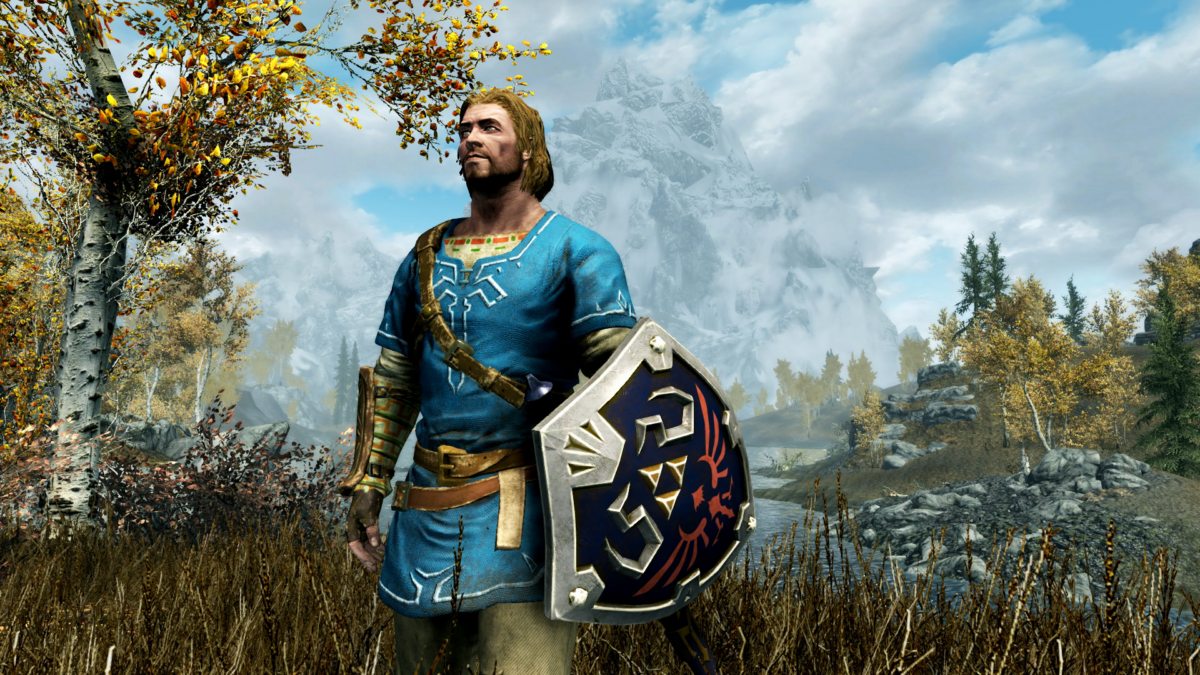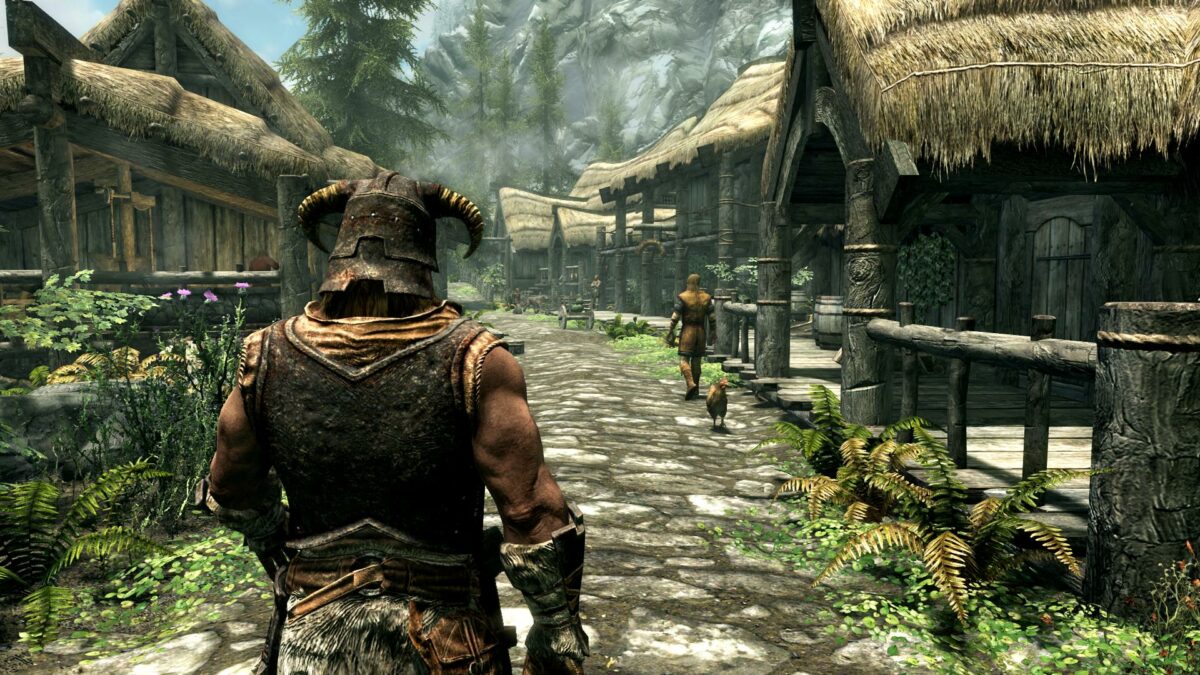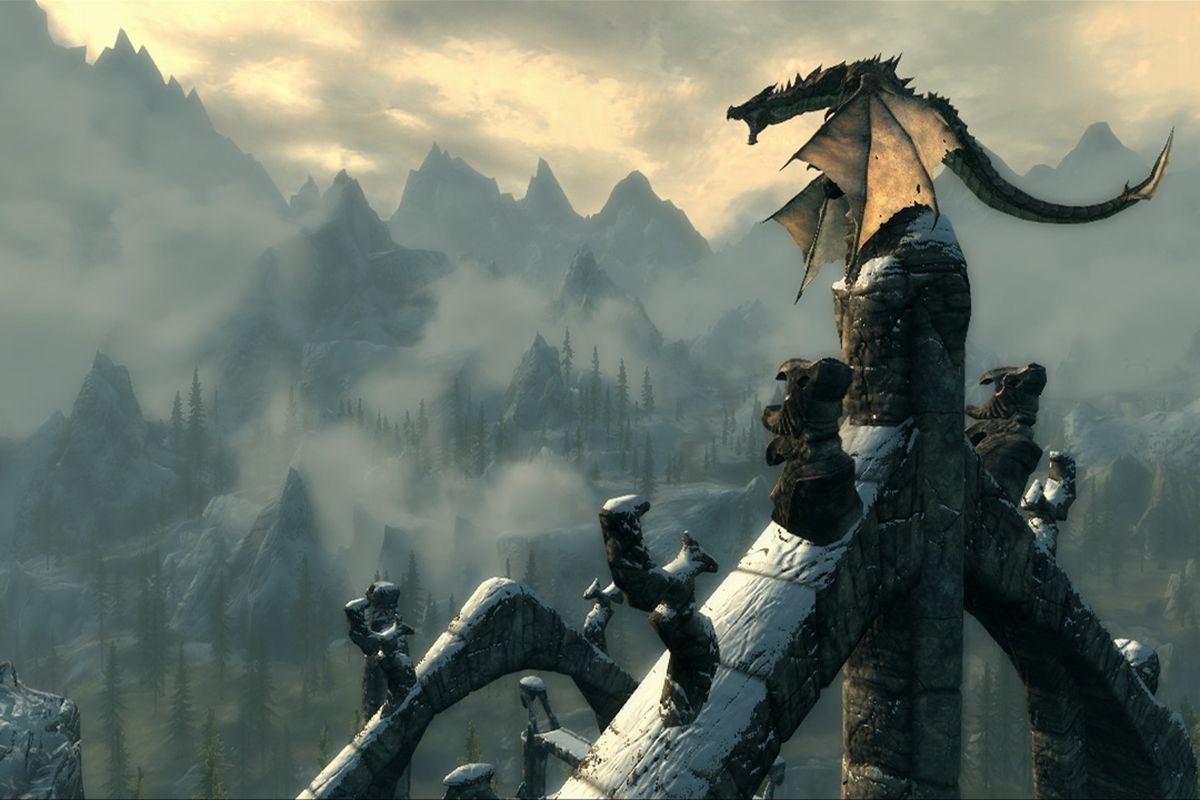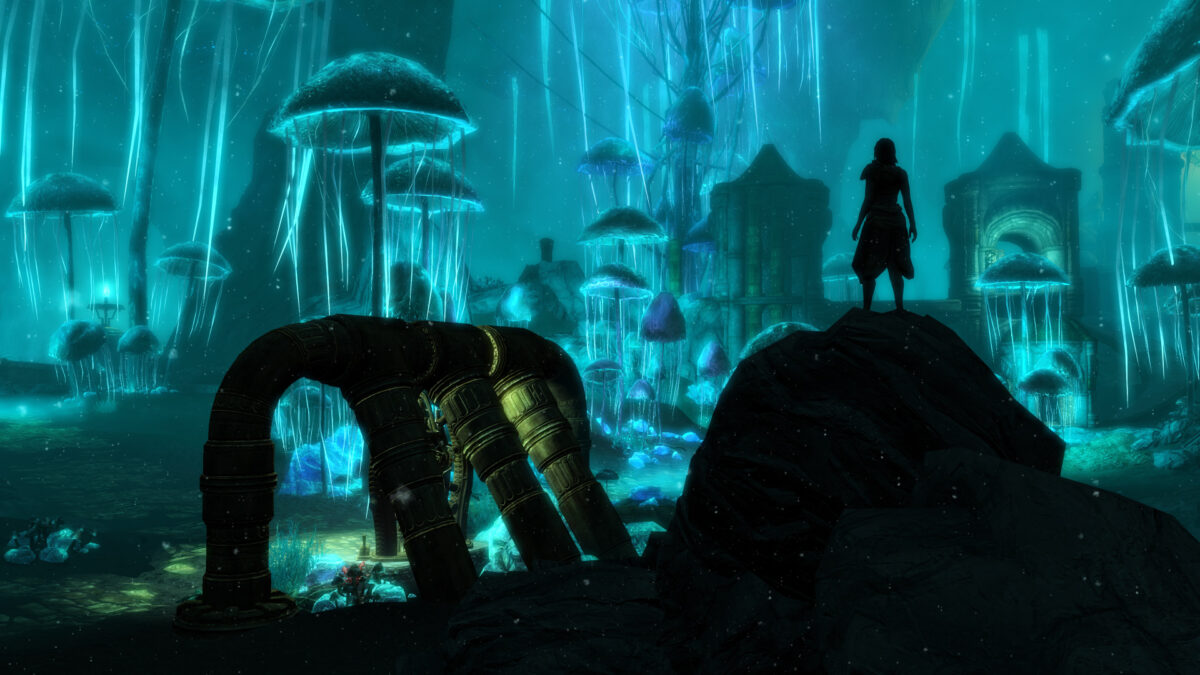We recently published a lengthy interview with Skyrim lead level designer Joel Burgess on how Blackreach, one of the game’s most famous dungeons, could have never existed. The reason it did was thanks to a process called spotlighting, which allowed the devs to pay extra attention to aspects of the game that were promising but needed some extra love.
Naturally, there was also an opposite, unnamed process. If something wasn’t going to plan, and was exhausting too much cash and too many resources, there would come a time where a decision would need to be made about whether to continue spending time and money on it, or cut it. One of the most fascinating cuts from Skyrim saw the removal of a whole new species: centaurs. Bet you didn’t know how much effort went into scripting butterflies, either — but more on that latter.
“We knew we wanted to have giant mammoths, we knew we wanted giants, and we knew we wanted centaurs because those are all in the early sketches,” Burgess says. “But they didn’t get past the concept stage. In those early days, we didn’t know we were going to cut them. So we’re sitting trying to figure out, like, what is the connection between everything? We had talked as a group and worked on this idea that the mammoths should feel really special and sacrosanct. They should feel like a sacred creature that is iconic and symbolic of a land like Skyrim.
“And then we had these giants. We liked this idea of the giants being gentle and peaceful — they were just extremely powerful, like a powerful dog that you antagonize at the park is going to hurt you when it bites you, but only because you went and poked him with a sharp stick.”

Giants and mammoths obviously made it into the final game, with elements from the original vision feeding into their relationship — we can clearly see the practice of animal husbandry and the inherent companionship shared between the two species. It’s also evidently designed to be a unique encounter type. As Burgess puts it, from a “capital V video game perspective,” giant camps are official points of interest and involve different kinds of combat, from the mammoths’ sweep attacks to giants doing area-of-effect damage with their clubs.
“And then we also had the centaurs,” Burgess says. “The centaurs didn’t have a lot of lore around them, they were something new that maybe had been mentioned in some old lore book. And we came around the idea of like, sometimes you have sacred animals. We had been thinking maybe the giants are vegetarians but not vegans. They eat the cheese but they don’t butcher the mammoths. Maybe they do the elephant burial ground thing from the real world. I think that idea shows up in the game — we have some mammoth burial grounds giants are protecting and tending to.
[mm-video type=video id=01fqmm392cd3652x3drr playlist_id=none player_id=none image=https://images2.minutemediacdn.com/image/upload/video/thumbnail/mmplus/01fqmm392cd3652x3drr/01fqmm392cd3652x3drr-f458f0c2ee01f00511e1a95aa32ad03d.jpg]
“But then we explore the sacred animal through a different cultural lens of something like the sacred beast. And that’s where we thought the centaurs would be cool. The centaurs are this group that lives out in the wild and they hunt the mammoths. And then we can have this natural tension, where we can have centaurs be more nomadic, they sort of move around the landscape. When they come across a mammoth and start a mammoth hunt, that would naturally incense a giant — you get this nice triangle of centaurs, mammoths, and giants. And that just tended to be the way we thought about all of our creature encounters as much as we could. I mean, draugr show up in places where ancient Nords are buried and Falmer show up in places where you have the dark elf stuff going on with the Dwemer. It gave us the building blocks for players being able to exist in a place that has sensible cohesion and feels thought through.”

So what happened? Somewhat ironically, Bethesda pumped a huge amount of time and effort into Skyrim’s “upscale” creatures. Previously, stuff like Liberty Prime in Fallout 3 had been very scripted, although this time around the studio was focusing on figuring out how to seamlessly integrate dragons, giants, and mammoths into the world so that they just existed of their own accord. Dragons should be able to land; mammoths should be able to roam the plains; and a giant should know that it can’t fit through the same door as a little person, which Burgess notes was not necessarily true of Oblivion or Fallout 3.
While all of this was going on, the team was also working on implementing horses into the game. There are a lot of technicalities when it comes to making a video game model move, from pivot points to character controllers, and movement in general has become more sophisticated and seamless in the years since Skyrim came out. At the time, however, Skyrim hadn’t fully made the leap to more modern mobility systems, which was most obvious in its quadrupeds.
While the team eventually managed to work something out with wolves, whose heads would turn ahead of their bodies, they never quite figured out horses in time for release — this is perhaps best seen in the infamous Skyrim horse glitch. At this point, Bethesda had a choice to make: continue burning time and money on fixing the horses; cut the horses; or just stop emphasising the horses. The studio chose the third option.

“If we had cut horses, there wouldn’t be horses, right?” Burgess explains. “In all the Skyrim memes about the horse on the mountain, you can sort of see the problem there, where the horse is moving on a central point and its body isn’t conforming. So we left the horses in, you can mount horses and ride them around. But we decided to stop trying to solve some of the problems. And importantly, we decided to cut some of the work that depended on the horses — crucially, mounted combat, which would come back later in DLC, and the centaurs.
“Because the centaurs are going to be an entire encounter type based around like… being a centaur, right? It’s not just a horse, it’s even more complicated than a horse because now you have a horse that can stop and turn and shoot an arrow while it’s running at you. If you want a centaur to feel right, that’s how it has to go. The decision was made before anything had gone into the centaur. I don’t think we ever modelled it, I think they’re just concept art pieces. And so yeah, it was cut. And what that left us with was the mammoth and giant ecology, that relationship — it just meant we lost that third element to it.
“Like Blackreach, it’s one of those things where if you make the decision at the right moment, it’s a clean break. Nobody plays Skyrim and goes like, ‘Something’s missing, I think it’s a centaur’. You don’t know we had these plans. I’ve always been a bit sad because I was really excited about what we could do with the centaurs, exploring their culture and all that. But at the end of the day it was a good cut. If we’d kept banging our heads against the wall and built a bunch of centaur art, what are we gonna do – rebrand it? Centaurs are dead?”
Decisions like this were commonplace due to how tight a schedule Skyrim was operating on. It was the same team of approximately 100 people who worked on Fallout 3, which shipped just three years prior to it, and the same team who would also go on to work on Fallout 4, which came out four years later. Both of these factors — the relatively low number of devs, at least by modern triple-A standards, and the quick turnaround time — made Bethesda extremely good at choosing what to prioritise and what to leave behind.

“It was more important that Skyrim had this number of dungeons or this number of weapon tiers for upgrades than it was that somebody spent an extra ten weeks making sure that horses took a crap and the crap became cold depending on where they took the crap,” Burgess says. “Not that Skyrim doesn’t have a bunch of those details, but we were pretty pragmatic about knowing when the details were really mattering to the end product and when they were just us kind of entertaining ourselves.”
As mentioned earlier, this resulted in the removal of centaurs, as well as a whole new skill based on spellcrafting. Because of these cuts though, the team were able to add more scripted story sequences like the flashbacks we see in the main quests, improve the Dragon Priest storyline, and design multiple different variants of dragons as opposed to just one standard type. In a way, choosing to put less into Skyrim’s horses directly influenced how well the dragons turned out. Probably for the best in a game about dragons.
After everything was wrapped and Skyrim had launched to enormous critical acclaim, the idea of DLC — which had been pioneered in Oblivion, expanded on in Fallout 3, and widely adopted by the industry at large — was floated. Obviously we’re aware of Dragonborn’s Solstheim and Dawnguard’s Castle Volkihar now, but it wasn’t just a case of ‘let’s build a big island off the coast of Skyrim and add some quests’.
[mm-video type=video id=01fneweg9c4wk5v2c2c9 playlist_id=none player_id=none image=https://images2.minutemediacdn.com/image/upload/video/thumbnail/mmplus/01fneweg9c4wk5v2c2c9/01fneweg9c4wk5v2c2c9-a0465eb771466761de4c34fc9ceabc05.jpg]
“The need for Solstheim and for the expansions to add new areas — this was something we actually kind of tried to avoid,” Burgess explains. “We built such a big game, why do we have to build more big game to add value? Player expectations come into that. We could try and do stuff — we had a way more complex Civil War system we had thought about bringing back with fully simulated battles happening. That was scaled way back.
“But when it comes to actual worldbuilding, one of the most instructive things I ever did was I went back to Morrowind. I played a bunch of Morrowind to meditate and ruminate on things. And like a lot of people, I installed a bunch of mods and was running far better hardware than whenever I first played Morrowind before I worked at Bethesda. Once you install level of detail so you can see distant mountains and stuff, and change the fog of the world, Morrowind doesn’t work anymore. The distance from Balmora to Vivec feels massive, like I’m travelling to the Ash Mountain. Once you add LOD and you take away the fog — oh there’s Vivec’s house, there’s the mountain. The density of that world doesn’t work anymore because the vibe doesn’t work.”

This is when the team realised that, despite initially being against the idea of building yet another massive part of the map, Solstheim was necessary to preserve the atmosphere of Skyrim. “I would argue — and I think I did at the time — you can’t really just add a dozen new forts to that map,” Burgess says. “I mean, you could, there are spaces where you could. But the world and the vibe would slowly and irrevocably change the more you added stuff, and then you’d start having to get cute about having holes, or towers, or magic portals or whatever.
“You could add a thing here and there if you need a new dungeon for DLC, or a new point of interest or camp. But if you’re going to try and add a Solstheim level of content onto the existing map, you’re going to be touching a bunch of stuff, having to retest a bunch of stuff, and you’ll be changing a pretty carefully tuned feeling of exploration.”
It’s easy to see the words “carefully tuned” and think, “Yeah, I suppose Skyrim is pretty detailed.” You’ve got massive spectacles of architecture like Dragonsreach and the Blue Palace, incredible feats of nature like the Throat of the World, and hidden havens like the sublime Ancestor Glade. Those are just the big set pieces, though — when it comes to being “carefully tuned,” to focus on those alone is to do Skyrim a disservice.
“Something I tend to admire about certain games is the confidence in quiet moments,” Burgess explains. “A lot of teams or individuals I’ve talked game design with have a hard time in the heat of thinking about E3 or making a 32nd trailer or whatever. The focus tends to be on the spectacle, and the biggest, most obvious, most exciting thing in the game.
“Sometimes you end up feeling that when you play the final game, and you’re not watching the 15-minute demo in a theatre at E3, you’re playing it after dinner, five hours in at your house, it’s like, ‘Oh, this game is set-piece spectacle surrounded by filler’. The critters – butterflies, fish, fireflies, and so on – and a lot of the small details are about filling in those middle spaces meaningfully and letting the game have the quiet moments and the confidence for that.”

These “critters,” despite being much smaller in scale than most of the things people discuss when they reminisce on Skyrim, actually have one of the most fascinating stories about the entire game behind them. They were planned — sort of — but not in a way that was remotely close to how they ended up shipping. Originally, they were supposed to be made with a particle system that would allow animated butterflies to move around in little swarms. Instead, their addition became a huge point of tension in the studio.
“There was a confluence of things that ended up producing the critter system as it was,” Burgess says. “There was an inherent dissatisfaction with the most superficial way of doing it. For a game where I can pick up an individual strawberry, and that strawberry has statistics and I can put it into a potion and apply it to a sword as a poison, having butterflies that were just fake particles flying around didn’t feel cohesive with the style of the game.”
Fortunately, Skyrim creative director Todd Howard was of the same opinion, and constantly pushed for verisimilitude to be paramount in designing the simulation. It wasn’t just that the butterflies needed to be an active reagent in the world — they needed to serve the sense of scale by being positioned opposite the likes of giants and dragons.
That wasn’t the point of contention, though. When it came time to start implementing critters into Skyrim, Bethesda was in the process of introducing a new scripting language called Papyrus. A lot of the devs who had been there for a while weren’t sold on it, so Burgess and his team saw critters as a golden opportunity for proving that Papyrus could accomplish powerful things that just weren’t possible using the old tech — fish would school, butterflies would be attracted to flowers, lightning bugs would glow in the dark, and so on. It was a controversial subject to broach in the studio, with some devs being anti-Papyrus purely due to the fact it was different.

“One of the things that happens when you’re making the first ambitious implementation of a new feature is it generates bugs — no pun intended,” Burgess says. “But the bugs created bugs. For example, when we were putting in the new scripting commands, we had safety features in the game that said like, ‘hey, this script is running a lot and it could be hurting your frame rate’ and it would pop a warning. Anybody who plays games has probably accidentally triggered a warning before.
“And so we would do work on the system and things would get checked in, and then the next day we might have a playtest and everybody on the team would get a popup that says, ‘The following script is running 50 instances and could be frilling your frame rate’ and the name of the script would be like, critter dot PSC slash butterfly. And so then pitchforks would come out like ‘why the **** are we putting butterflies in the game? ****ing Dragons and you got a butterfly.’”
A good and recently famous example of the complexities imbued in these little creatures actually comes from Burgess’ friend, Nate “Purkey” Purkeypile, who posted about how a bee broke the Skyrim intro on Twitter. Bees weren’t technically critters in the conventional sense — Burgess had originally considered trying to make bees attack you if you had honey in your inventory, but it didn’t work out — but the point stands: Even the most ostensibly minor parts of Skyrim can serve major purposes.
“There were definitely people who were ideologically opposed to the critter system, which I thought was a really interesting litmus test of like, what’s more important to Skyrim — is it dragons or butterflies?” Burgess asks. “I mean, the fact that’s even a question that would be interesting to talk about over dinner with some friends says a lot about Skyrim. Probably the dragons, but you could at least talk about it over beers. Both of these things define the game in pretty equal measure, because I think if you took a game like Skyrim and you dropped getting married and picking flowers and all of those quieter, cosier elements, the entire game would feel a lot more hollow and cynical. I think from a very soft-touch point of view, these things are important. They’re worth the effort.”
They’re also indicative of an important design principle at Bethesda in general, which is that things should just work because they’re supposed to. That’s been the design ethos at the studio ever since its more obscure games like Daggerfall and even Morrowind. The people who went to work at Bethesda didn’t do it just because it was a job they saw advertised in the paper — they did it because they loved these games and wanted to help make more of them. That sentiment serves as a pretty nice bowtie for everything discussed in this piece, from the removal of centaurs to focus on other aspects of Skyrim to the push for butterflies to be tangible objects in the world.
“If you go and play the old Hitman games, it was like, here is a villa,” Burgess explains. “There are windows and air ducts and a basement entrance and this catering stuff. Here is just a toy box. And if I go into the toy box and I want to use a door this way, things just work the way they ought to work. Some of the best Dark Brotherhood quests are just ‘go kill that guy’. There’s no scripted, special way to do it.
“There’s no dungeon, it’s one of those things where the harder you work to make it feel special the less special it feels. Because it’s like, the designer put a bunch of time into this sequence of events that felt very cool or cinematic and I felt like I had no personal input. I had no agency. And I’m just checking off the choreography. For me, and I think for a lot of Bethesda developers particularly of that time period, that sort of immersive sim mentality of things should just work, and respond the way the player would intuitively expect them to work, is why the idea of butterflies that just fly through players was wildly offensive. Instead, we have a game where players can have a discussion about ‘Oh, the best way to gather butterfly wings is to equip a spell with a big cone effect and then find a cloud of butterflies so you can quickly kill the butterflies and pick their wings up off the ground.’ I love that that stuff exists.”
Written by Cian Maher on behalf of GLHF.
[listicle id=1389708]






































